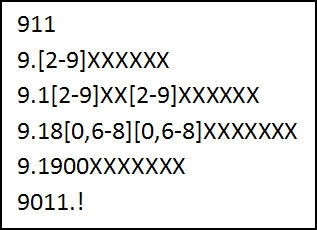Implementing Cisco IP Telephony and Video, Part 1 (CIPTV1) v1.0
Question 1
Which parameter is required on MCU for ad hoc conferencing?
- A. Media Port reservation
- B. incoming calls to unknown conferences or auto-attendants
- C. DSP reservation for video
- D. MCU type
- E. MCU Conference Bridge SIP Port
Answer : B
Question 2
Which three steps must you take on Cisco Unified Communications Manager to configure Cisco TelePresence Conductor for ad hoc and rendezvous conferences? (Choose three.)
- A. Verify the location configuration.
- B. Verify the certificate trusts.
- C. Configure one ICT trunk to TelePresence Conductor.
- D. Configure one SIP trunk to TelePresence Conductor.
- E. Configure two ICT trunks to TelePresence Conductor.
- F. Configure two SIP trunks to TelePresence Conductor.
Answer : ABD
Question 3
Which of these methods can be used to implement toll-fraud prevention?
- A. drop conferences when only two attendees remain
- B. block on-net to on-net calls
- C. deploy conferencing resources to only those employees that require the service
- D. drop conferences when no on-net party remains
Answer : D
Question 4
Which four modes are available on the Cisco TelePresence MCU MSE 8510 to connect to a gatekeeper? (Choose four.)
- A. direct mode
- B. H.225-routed mode
- C. H.265-routed mode
- D. H.245-routed mode
- E. full proxy mode
- F. partial proxy mode
Answer : ABDE
Question 5
Which DiffServ PHB classification is recommended by Cisco for interactive video traffic?
- A. AF31
- B. CS3
- C. EF
- D. AF41
- E. CS4
Answer : D
Question 6
Which three descriptions are true? (Choose three.)
- A. The class of service is a parameter that is used for traffic classification and marking at Layer 2.
- B. The IP precedence is a parameter that is used for traffic classification and marking at Layer 2.
- C. The differentiated services code point is a parameter that is used for traffic classification and marking at Layer 2.
- D. The class of service is a parameter that is used for traffic classification and marking at Layer 3.
- E. The IP precedence is a parameter that is used for traffic classification and marking at Layer 3.
- F. The differentiated services code point is a parameter that is used for traffic classification and marking at Layer 3.
Answer : AEF
Question 7
On what equipment do you configure Layer 2 to Layer 3 QoS mapping?
- A. switch
- B. router
- C. firewall
- D. Cisco Unified Communications Manager
- E. bridge
Answer : B
Question 8
Which mechanism is often configured on the edges of a network to control the maximum rate of traffic that is sent or received on an interface and to classify the traffic into priority levels or class of service?
- A. routing
- B. shaping
- C. policing
- D. access control
- E. traffic regulation
Answer : C
Question 9
Which three characteristics of a video stream require the implementation of QoS? (Choose three.)
- A. variable packet rate
- B. constant bandwidth
- C. small packets
- D. high MTU
- E. high packet rate
Answer : ADE
Question 10
You need to delete an auto-registration Cisco Unified Communications Manager group for a cluster. What should you do?
- A. Remove the Cisco Unified CallManager group devices.
- B. Disable auto-registration settings in the Cisco Unified CallManager group.
- C. Assign a different call group as the auto-registration Cisco Unified CallManager group.
- D. Delete the auto-registration Cisco Unified CallManager group without performing any action.
Answer : C
Question 11
Which of these determines the Cisco Unified Communications Manager server to which an IP phone registers?
- A. The Cisco Unified Communications Manager group is configured with a Device Pool that designates the primary, secondary, and tertiary servers in the group.
- B. Each IP phone is configured with a Device Pool containing the Cisco Unified Communications Manager group that determines which server the IP phone will use as its primary, secondary, and tertiary server.
- C. Each IP phone is configured with its primary, secondary, and tertiary server.
- D. The Cisco Unified Communications Manager group is configured in the publisher to designate the IP phone groups that will register with the primary, secondary, and tertiary servers in the group.
Answer : B
Question 12
Which Cisco Unified Communications Manager menu path is used to access the softkey template configuration window?
- A. Device > Device Settings > Softkey Templates
- B. Device Settings > Softkey Templates
- C. IP Phone > Template > Softkey
- D. Device > IP Phone > Template > Softkey
Answer : A
Question 13
Where is a Local Route Group configuration applied?
- A. In each IP phone
- B. In each device pool
- C. In each location
- D. In each region
- E. In each route list
Answer : B
Question 14
If no SIP dial rules are configured on an IP phone, at which three points in the collection of digits does a Type A SIP phone send digits to the Cisco Unified
Communications Manager? (Choose three.)
- A. when the interdigit timer expires
- B. when the collected digits match a SIP dial rule
- C. when the user presses the Dial softkey
- D. as each digit is collected (it is sent for analysis)
- E. when the user presses the # key
Answer : ACE
Question 15
Refer to the exhibit.

To reach an external number, a user first dials a 9. Which route pattern will be matched if a user dials the toll-free number 18005550123?
- A. 911
- B. 9.[2-9]XXXXXX
- C. 9.1[2-9]XX[2-9]XXXXXX
- D. 9.18[0,6-8][0,6-8]XXXXXXX
- E. 9.1900XXXXXXX
- F. 9011!
Answer : D